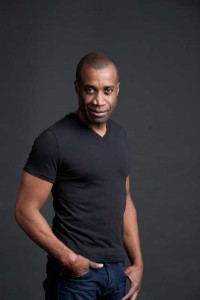
BET‘s The Book of Negroes tells the sweeping tale of Aminata Diallo (Aunjanue Ellis), who is kidnapped from her village in Africa and sold as a slave in South Carolina. The series is based on the award-winning novel Someone Knows My Name by Lawrence Hill. Hill served as a writer, along with producer and director Clement Virgo. Virgo is a Canadian filmmaker who has directed multiple episodes of The Wire for HBO, as well as The L Word and Soul Food for Showtime. He is known for his film Lie With Me, which was featured at the 2005 Toronto International Film Festival and sold to Showtime in the U.S., and Poor Boy’s Game, which is a boxing drama that premiered at the 2006 Berlin Film Festival.
For the past several years, Virgo has focused his attention on bringing The Book of Negroes to the screen. “Aminata was my real access into the story,” said Virgo. “I fell in love with her.” The sheer will and resourcefulness of this character touched him. Virgo had always wanted to make a slavery narrative in his filmmaking career. Once he picked up the novel about Aminata and read the first line, “I think I have trouble dying,” he was hooked. He had now found his subject. “Her story really compelled me. It reads like an action-adventure story to me,” he stated.
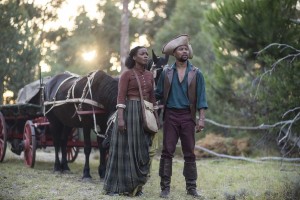
Virgo originally set out to make a feature film, but then decided to explore the renaissance of television and switched outlets and came up with the idea of a six-part series. He began working on a script with the novel’s author Hill. The writing period took two years. Based on the script, he approached BET and the series found a home. The real journey though, for Virgo, laid in telling the story. “It was about trying to get the story right, trying to get the same feeling I got when I read the novel. Obviously a novel is really different from a screenplay,” Virgo explained. A particular challenge in adapting the narrative was the many characters that come in and out of Aminata’s life in the novel. “With the miniseries, with the screenplay, I wanted to make sure these characters stick around for longer in her life, that we develop feelings for these characters, that we fell in love with them.”
When the script was ready to go, Virgo enlisted Giulio Bicarri onto his team as the cinematographer. The planning with Biccari was extensive, with the two discussing the cinematography of many films. They shared similar sensibilities and realized early on that this series was not one where there should be a crane shot. They also decided together to set out on creating a subjective experience. “We had this rule where the camera moved when she moved. So if Aminata’s being pulled to be branded, the camera moved with her,” Virgo said.
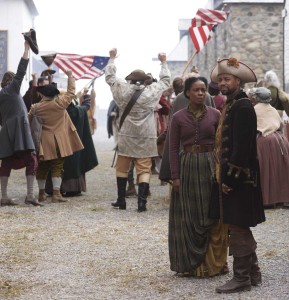 Roman Polanski‘s films, such as The Pianist and Chinatown, served as inspiration. Many of Polanski’s films delve deep into the imagination of the characters and Virgo wanted to explore that effect in this series. “So that means a lot of cameras on the main character’s shoulder to observe what she’s observing,” Virgo noted. Virgo discussed color at length with Biccari, his production designer and costume designer. “We talked about what each sequence, what each journey of Aminata’s color palette was. I didn’t want it to feel dark and miserable. I wanted it to have a transcendence,” he said.
Roman Polanski‘s films, such as The Pianist and Chinatown, served as inspiration. Many of Polanski’s films delve deep into the imagination of the characters and Virgo wanted to explore that effect in this series. “So that means a lot of cameras on the main character’s shoulder to observe what she’s observing,” Virgo noted. Virgo discussed color at length with Biccari, his production designer and costume designer. “We talked about what each sequence, what each journey of Aminata’s color palette was. I didn’t want it to feel dark and miserable. I wanted it to have a transcendence,” he said.
Another endeavor when it came to the photography was to create the look of intimacy. Virgo wanted the story to feel big, but without it becoming a spectacle. “So a lot of the camera was a subjective, intimate experience. It wasn’t the big crane, swooping, shots. We wanted to create a psychological, emotional experience. You’re dealing with a world with a lot of brutality and I didn’t want to exhaust the audience. I wanted the audience to feel the story instead of just watch the story. We employed camerawork and visuals that pull you into the story, pull you into the screen and pull you into Aminata’s journey instead of just a detached watching of the horror on the screen,” he explained.
Kye Meechan and Susan Shipton edited the series. It was the first time the director had worked with the two editors, but he soon established an idyllic working rhythm with both. Virgo was impressed by Meechan’s visual poetic editing style. “I tend to want to work with people who are artists and who bring their own interpretation to the material,” he stated. Both editors fit this criteria well and it was especially helpful that they brought their own individuality to the project. “It was important to me to also have a female perspective on the journey. Susan would always challenge me in terms of the point of view, in terms of what Aminata may or may not be feeling in the moment in the story.”
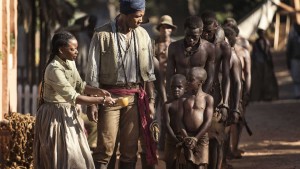 Creating the world of Aminata in the production design was a collaborative effort. The credit is shared between Jason Clarke, Brian Glaser and Anthony A. Ianni. “We talked about trying to create our own world. I wanted the first episode, the world of the young child to be innocent. I was concerned about creating a mythology around Africa. But at the same time, the profession of the first episode is from a child’s point of view and for a child, in some ways, you see the world through rose-colored glasses,” Virgo explained. Creating this world of innocence fit in with using a naturalistic color palette. There’s no certainty about what Africa looked like in 1761 because there are no images and paintings of the place during that time so Virgo and his team had to construct a culture.
Creating the world of Aminata in the production design was a collaborative effort. The credit is shared between Jason Clarke, Brian Glaser and Anthony A. Ianni. “We talked about trying to create our own world. I wanted the first episode, the world of the young child to be innocent. I was concerned about creating a mythology around Africa. But at the same time, the profession of the first episode is from a child’s point of view and for a child, in some ways, you see the world through rose-colored glasses,” Virgo explained. Creating this world of innocence fit in with using a naturalistic color palette. There’s no certainty about what Africa looked like in 1761 because there are no images and paintings of the place during that time so Virgo and his team had to construct a culture.
Once Aminata is captured from her home and embarks on the long road to the ocean, the storytelling faced many challenges. “We wanted to give a sense of the journey she was on. How do you create a sense of the three-month journey that slaves had to take to get to the ocean? They had to pass through jungle. They had to pass through desert. We had to figure out how to do that all in South Africa. How do we find a desert that’s white sand? How do we find different vegetation? So we crafted a visual journey within a journey on the way to the ocean,” he said.
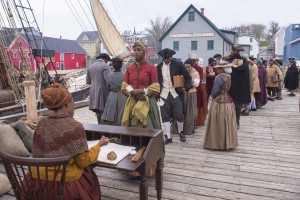 Costume designer Kate Carin hails from South Africa and was a perfect fit for this project. Virgo wanted Aminata to be unique. So he instructed Carin to take an old-school Hollywood approach of making the lead actress look as best as she could. “We went an old-fashioned way, which is to ensure our leading lady looked great. Kate came up with these beautiful looks.” The task not only involved dressing the character beautifully, but also telling the story through what she wears. As a slave in South Carolina, Aminata’s clothing is more constricted, but when she makes her way to New York and she breaks free, her clothing also becomes more free,” the director explained.
Costume designer Kate Carin hails from South Africa and was a perfect fit for this project. Virgo wanted Aminata to be unique. So he instructed Carin to take an old-school Hollywood approach of making the lead actress look as best as she could. “We went an old-fashioned way, which is to ensure our leading lady looked great. Kate came up with these beautiful looks.” The task not only involved dressing the character beautifully, but also telling the story through what she wears. As a slave in South Carolina, Aminata’s clothing is more constricted, but when she makes her way to New York and she breaks free, her clothing also becomes more free,” the director explained.
Virgo’s other main concern when it came to the costume design was to not present the slaves as downtrodden in the way they appeared. He didn’t want to overemphasis their circumstances by having the characters look dirty and messy. “I look around and I know that it doesn’t matter who you are, or how poor you are, you’re going to try to look your best. If Aminata is going to see her man, it doesn’t matter that she’s a slave, she’s going to try to look good. If her man is going to see her, he’s going to put on the best shirt that he can,” he said.
Virgo’s favorite memory from making this series happened on the beach in South Africa. He was shooting a scene and he realized he was on a beautiful sandy beach surrounded by mountains. “I just stopped. I looked over at the ocean, I looked at the mountains and I looked at the blue sky and I thought ‘I’m in Africa! And I’m shooting!’ It was one of these rare moments where you are present, where you suddenly become aware of the moment. You’re here. You’re on this beach. You’re on this beautiful continent and you’re doing exactly what you want to do in life.”





